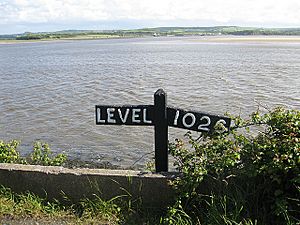Grade (slope) facts for kids
For other uses see: Gradient (disambiguation)
When you walk or ride on a road or railway line, you might notice it goes up or down. The grade (or gradient) is a way to measure how steep that path is. It tells you how much the ground rises or falls over a certain distance. For example, a gradient of 1% means the path goes up or down 1 meter for every 100 meters you travel forward. This helps engineers design safe roads and railways.
Contents
What is a Gradient?
A gradient describes the slope of a surface. It shows how much something changes in height over a horizontal distance. Think of it like a ramp. A very steep ramp has a high gradient, while a flat path has a zero gradient. Gradients are important for many things, from building roads to designing roller coasters.
How Gradients are Measured
Gradients can be shown in a few different ways. The most common ways are as a percentage or as a ratio.
Percentage Gradient
When you see a gradient as a percentage, it tells you the vertical rise (or fall) for every 100 units of horizontal distance.
- A 1% gradient means the path goes up or down 1 meter for every 100 meters forward.
- A 10% gradient means it changes 10 meters in height for every 100 meters forward.
- A 100% gradient means the path rises 100 meters for every 100 meters forward. This is a very steep slope, like a 45-degree angle!
Ratio Gradient
Sometimes, gradients are shown as a ratio, like "1 in 100." This means that for every 100 units you travel horizontally, the path rises or falls by 1 unit vertically.
- A "1 in 50" gradient is steeper than a "1 in 100" gradient. This is because you gain or lose more height over a shorter distance.
- Railway lines often use ratios because trains need very gentle slopes to operate safely.
Angle Gradient
Less commonly, gradients can be expressed as an angle in degrees. This is the angle the slope makes with the horizontal ground. For example, a 45-degree slope is very steep.
Why Gradients Matter
Gradients are super important for many reasons, especially in transportation and construction.
Roads and Driving
Drivers need to know about gradients. Steep uphill roads make engines work harder. Steep downhill roads require careful braking to avoid losing control. Road signs often warn drivers about steep grades so they can drive safely. For example, a sign might show "20%" to warn of a very steep hill.
Railways and Trains
Trains are very heavy and need almost flat tracks. Even a small gradient can be a big challenge for a train. This is why railway lines often have long, gentle slopes. Engineers work hard to keep gradients low when building new railway tracks.
Biking and Hiking
If you enjoy biking or hiking, you know how much gradients affect your journey. A steep uphill climb can be very tiring. Downhill sections can be fast and exciting, but also require good control. Knowing the gradient helps you plan your route and prepare for the effort needed.
Construction and Design
Engineers and builders always consider gradients. When building houses, roads, or even drainage systems, the slope of the land affects how water flows and how stable structures will be.
Images for kids
-
Grade indicator near Bellville, Western Cape, South Africa, showing 1:150 and 1:88 grades.
-
A 1371-metre long stretch of railroad with a 20‰ (2%) slope, Czech Republic
-
25% ascent warning sign, Wales
-
A trolleybus climbing an 18% grade in Seattle
-
A car parked on Baldwin Street, Dunedin, New Zealand
-
Looking down Canton Avenue, Pittsburgh, Pennsylvania
See also
 In Spanish: Pendiente (geografía) para niños
In Spanish: Pendiente (geografía) para niños











